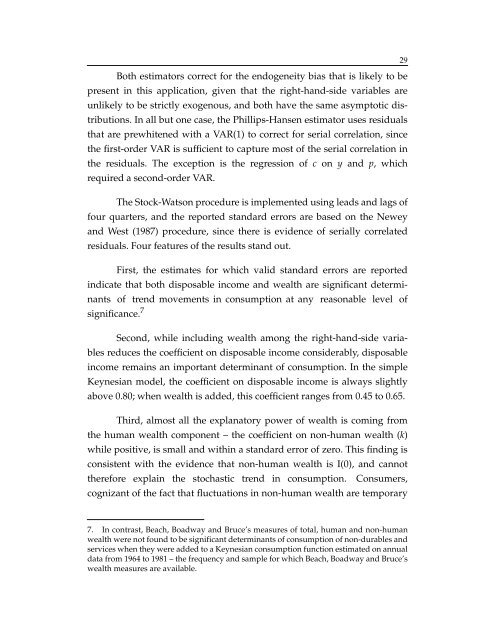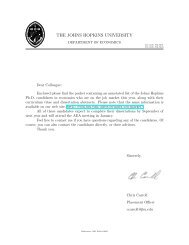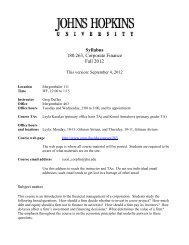WEALTH, DISPOSABLE INCOME AND CONSUMPTION - Economics
WEALTH, DISPOSABLE INCOME AND CONSUMPTION - Economics
WEALTH, DISPOSABLE INCOME AND CONSUMPTION - Economics
You also want an ePaper? Increase the reach of your titles
YUMPU automatically turns print PDFs into web optimized ePapers that Google loves.
Both estimators correct for the endogeneity bias that is likely to be<br />
present in this application, given that the right-hand-side variables are<br />
unlikely to be strictly exogenous, and both have the same asymptotic distributions.<br />
In all but one case, the Phillips-Hansen estimator uses residuals<br />
that are prewhitened with a VAR(1) to correct for serial correlation, since<br />
the first-order VAR is sufficient to capture most of the serial correlation in<br />
the residuals. The exception is the regression of c on y and p, which<br />
required a second-order VAR.<br />
The Stock-Watson procedure is implemented using leads and lags of<br />
four quarters, and the reported standard errors are based on the Newey<br />
and West (1987) procedure, since there is evidence of serially correlated<br />
residuals. Four features of the results stand out.<br />
First, the estimates for which valid standard errors are reported<br />
indicate that both disposable income and wealth are significant determinants<br />
of trend movements in consumption at any reasonable level of<br />
significance. 7<br />
Second, while including wealth among the right-hand-side variables<br />
reduces the coefficient on disposable income considerably, disposable<br />
income remains an important determinant of consumption. In the simple<br />
Keynesian model, the coefficient on disposable income is always slightly<br />
above 0.80; when wealth is added, this coefficient ranges from 0.45 to 0.65.<br />
Third, almost all the explanatory power of wealth is coming from<br />
the human wealth component – the coefficient on non-human wealth (k)<br />
while positive, is small and within a standard error of zero. This finding is<br />
consistent with the evidence that non-human wealth is I(0), and cannot<br />
therefore explain the stochastic trend in consumption. Consumers,<br />
cognizant of the fact that fluctuations in non-human wealth are temporary<br />
7. In contrast, Beach, Boadway and Bruce’s measures of total, human and non-human<br />
wealth were not found to be significant determinants of consumption of non-durables and<br />
services when they were added to a Keynesian consumption function estimated on annual<br />
data from 1964 to 1981 – the frequency and sample for which Beach, Boadway and Bruce’s<br />
wealth measures are available.<br />
29




